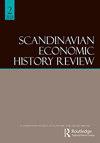Industrious migrants: gender and the earnings of migrants in Swedish manufacturing around 1900
IF 0.5
Q4 ECONOMICS
引用次数: 0
Abstract
ABSTRACT Migration played a central role in industrialisation by reallocating labour from the countryside to urban areas and centres of manufacturing where it was in high demand, and better remunerated, with implications for economic growth and individual well-being. We investigate the labour market performance of internal migrants in Sweden around the turn of the last century; a period of industrialisation and increasing migration. We add to the literature in two ways: first by focusing on earnings instead of occupational attainment; second by extending the scope beyond the prevailing focus on men by also considering women. To assess how migrants fared compared to locals, we use detailed matched firm-individual data covering three manufacturing industries which varied in terms of production, organisation, and composition of the workforce. We find that migrants, irrespective of gender, performed well in that their earnings were higher than those of locals in general and of co-workers in the same firm. These premia are consistent with a Roy model in which migrants’ sort into locations where returns to skills match individual ability. An increase in both hours worked and effort further explains the observed earnings premium among female migrants.勤奋的移民:1900年前后瑞典制造业移民的性别和收入
移民在工业化中发挥了核心作用,将劳动力从农村重新分配到城市地区和制造业中心,在那里劳动力需求高,报酬高,对经济增长和个人福祉有影响。我们调查了上个世纪之交瑞典内部移民的劳动力市场表现;工业化和移民增加的时期。我们通过两种方式补充文献:首先是关注收入,而不是职业成就;第二,将范围扩大到普遍关注的男性之外,也考虑到女性。为了评估移民与本地人相比的表现,我们使用了详细的匹配公司-个人数据,涵盖了三个制造业,这些制造业在生产、组织和劳动力构成方面各不相同。我们发现,无论性别如何,移民的表现都很好,因为他们的收入总体上高于当地人和同一家公司的同事。这些溢价与罗伊的模型一致,在罗伊模型中,移民会进入技能回报与个人能力相匹配的地区。工作时间和努力的增加进一步解释了在女性移民中观察到的收入溢价。
本文章由计算机程序翻译,如有差异,请以英文原文为准。
求助全文
约1分钟内获得全文
求助全文
来源期刊

SCANDINAVIAN ECONOMIC HISTORY REVIEW
ECONOMICS-
CiteScore
1.60
自引率
16.70%
发文量
20
期刊介绍:
Scandinavian Economic History Review publishes articles and reviews in the broad field of Nordic economic, business and social history. The journal also publishes contributions from closely related fields, such as history of technology, maritime history and history of economic thought. Articles dealing with theoretical and methodological issues are also included. The editors aim to reflect contemporary research, thinking and debate in these fields, both within Scandinavia and more widely. The journal comprises a broad variety of aspects and approaches to economic and social history, ranging from macro economic history to business history, from quantitative to qualitative studies.
 求助内容:
求助内容: 应助结果提醒方式:
应助结果提醒方式:


